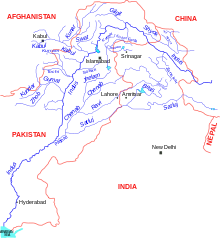Chenab River

The Chenab River (Sanskrit: चंद्रभाग, Punjabi: ਚਨਾਬ, canāb, Hindi: चनाब, Urdu: چناب, literally: 'Moon(Chan) چن River(aab)' آب) is formed by the confluence of the Chandra and Bhaga rivers at Tandi located in the upper Himalayas in the Lahul and Spiti District of Himachal Pradesh, India. In its upper reaches it is also known as the Chandrabhaga. It flows through the Jammu region of Jammu and Kashmir into the plains of the Punjab, forming the boundary between the Rechna and Jech interfluves (Doabs in Persian). It is joined by the Jhelum River at Trimmu تریمو and then by the Ravi River Ahmedpur Sial احمدپور سیال. It then merges with the Sutlej River near Uch Sharif, Pakistan to form the Panjnad or the 'Five Rivers', the fifth being the Beas River which joins the Satluj near Ferozepur, India. The Chenab then joins the Indus at Mithankot, Pakistan. The total length of the Chenab is approximately 960 kilometres. The waters of the Chenab are allocated to Pakistan under the terms of the Indus Waters Treaty.[1][2]
History
The river was known to Indians in the Vedic period[3] as Chandrabhaga (Sanskrit: चंद्रभाग), also Ashkini (Sanskrit: अश्किनि) or Iskmati (Sanskrit: इस्कामति) and as Acesines to the Ancient Greeks[4]. In 325 BC, Alexander the Great allegedly founded the town of Alexandria on the Indus (present day Uch Sharif or Mithankot or Chacharan in Pakistan) at the confluence of the Indus and the combined stream of Punjab rivers (currently known as the Panjnad River)[5].
The Chenab has the same place in the consciousness of the people of the Punjab as, say, the Rhine holds for the Germans, or the Danube for the Austrians and the Hungarians. It is the iconic river around which Punjabi consciousness revolves, and plays a prominent part in the tale of Heer Ranjha, the Punjabi national epic and the legend of Sohni Mahiwal.
This river has been in the news of late due to the steps taken by the Indian government to build a number of hydro power dams along its length (in India), notably the Baglihar hydel power project(expected time of completion 2008). This is a result of the Indus Basin Project. These planned projects on Chenab have been contested by Pakistan which says that India is breaking the terms and clauses of the Indus water treaty by storing and channeling the waters of this river, a claim rejected by the Indian government.
Bridges

The river is crossed in Jammu and Kashmir by the world's highest railway bridge named Chenab Bridge
See also
Notes
- ^ "River Chenab" (PDF). Retrieved 2007-06-17.
- ^ "Indus Waters Treaty". The World Bank. Retrieved 2007-06-17.
- ^ Yule, Henry. "Hobson-Jobson: A glossary of Anglo-Indian colloquial words & phrases and of kindred terms". Pg.741. Google Books. Retrieved 2009-05-29.
{{cite web}}: Unknown parameter|coauthors=ignored (|author=suggested) (help) - ^ Encyclopædia Britannica article on the Chenab
- ^ Alexandria (Uch)


